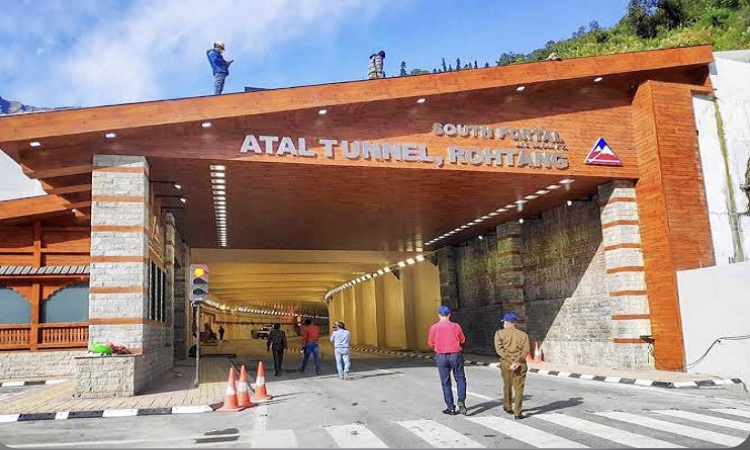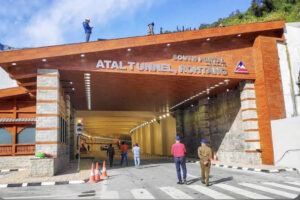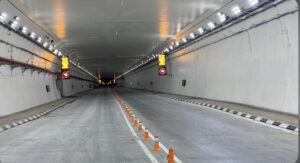Atal Tunnel is a highway tunnel built under the Rohtang Pass in the eastern Pir Panjal Range of the Himalayas on the Leh-Manali highway in Himachal Pradesh, India. At 9.02 km length, it is the longest tunnel above 10,000 feet (3,048 m) in the world and is named after former Indian Prime Minister Atal Bihari Vajpayee.
The tunnel reduced the distance between Manali and Leh by 46 km and reduced the travel time by 4 to 5 hours without any threat of road blockade or avalanche.
The 117 km distance from Manali to the south of the pass to Keyong on the north side of Rohtang Pass via Gramphu is usually covered by vehicles in about 5 hours to 6 hours without counting the long hours of traffic jams on the hilly route. The same journey is much easier now as Manali to the South Portal of the tunnel is 24.4 km approx 50 mins, through the tunnel is approximately 15 mins and without traffic snarls and North Portal to Keylong is 37 km approx 60 mins.
The tunnel is at an elevation of 3,100 meters whereas the Rohtang Pass is at an elevation of 3,978 meters.
It was inaugurated by Prime Minister Shree Narendra Modi on 3 October 2020. The approximate cost of this project is 3200 crore.
Project Timeline
- The total length of the Atal tunnel is 9.02 km.
- The project was announced by then Prime Minister Atal Bihari Vajpayee on 3rd June 2000. The work was entrusted to Border Roads Organization on 6th May 2002.
- As of June 2012, two years after the start of the project, 3.5 km of the tunnel digging had been completed.
- Only a little progress was made in the next year due to heavy ingress of water at serri nullah fault zone, the required constant dewatering, and slowed the digging and blasting to a crawl.
- As of Oct 2013, a little more than 4 km of the tunnel had been dug. However, about 30 m portions of the roof of the tunnel collapsed towards the north portal on 17 October 2013 and the digging had to be stopped.
- As of Sept 2014, 4.4 km of the tunnel i.e., half of 8.8 km planned length had been dug.
- As of Dec 2016, 7.6 km of the tunnel digging had been completed. The excavation was expected to be completed in 2017, with an opening in the second half of 2019.
- As of 3 September 2017, 276 meters of the tunnel digging work remained. Tunnel to be opened for emergency services like Ambulance to be opened by winters.
- As of 13th October 2017, both ends of the tunnel met. The Defense Minister, Nirmala Sitharaman visited the site on 15th October 2017.
- As on 22nd November 2017, it was decided to allow patients to be carried through the under-construction tunnel only in the gravest of emergency when the helicopter service was not available and not to allow civilians to enter the tunnel before completion of construction work due to risks of falling rocks, lack of oxygen in the tunnel as ventilation system was yet to be installed, etc. and likely interruption in construction work due to presence of civilians.
- September 2018: the tunnel was used for evacuation of people stranded in Lahaul after a sudden spell of bad weather blocked Rohtang La due to snowfall.
- January 2019: 90% works completed.
- October 2019: 100 meters work yet to be finished. To be opened for emergency traffic by October-2019 end. To be opened for general traffic by Sep-2020.
- November 2019: Bus service trial started through the yet – incomplete tunnel on 17 November 2019. A Himachal Road Transport Corporation bus carrying 44 passengers entered the tunnel from the south portal and the passengers alighted at the north portal. The bus service operated for the next five winter months for residents of Lahaul and Spiti valleys. Private vehicles were not allowed through the tunnel.
- December 2019: On the 25th of December the tunnel, which was known as Rohtang tunnel till then, was officially renamed as the Atal Tunnel.
- September 2020: 100% completion of the project.
- October 2020: The tunnel was inaugurated by Prime Minister Shree Narendra Modi on 3 October 2020.
Challenges Faces during Project Implementation
The most challenging task was to continue the excavation during heavy snowfall in winter. Excavation for tunneling was done from both ends. However, as Rohtang Pass closes during the winter, the north portal was not accessible during winter & the excavation was being done only from the south portal in winters. Only about ¼ of the entire tunnel was excavated from the north end and ¾ was excavated from the south end. There were more than forty-six avalanche sites on approaches to the tunnel.
Other challenges to the progress of the tunnel included difficulties in disposing of more than 800,000 m3 of excavation rock and soil, heavy ingress of water as much as 3 million liters per day in June 2012 that required constant dewatering, costlier treatment, and slowed the progress of excavation from 5- meter per day to just half a meter a day and unable rocks that slowed blasting and digging. A cloud-burst and flash flood on 8th August 2003 killed 42 laborers who were building the temporary access road.
Specifications
Salient features of the proposed Atal tunnel are as follows:
- The length of the Tunnel is 9.02 km
- The shape of the Tunnel: Horseshoe
- Finished width: 10.00 m at road level.
- General altitude of the tunnel: 3,000 m – 3,100 m or 9,840 ft – 10,170 ft
- Designated vehicular speed: 80km/h
- Geology of tunneling media: Uniformly dipping alternate sequence of quartzite, quartzite schist, quartz-diorite-schist with thin bands.
- Tunnel boring machines will not be used because of the inability to see inside the mountain, instead of blasting and digging will be used to build the tunnel.
- Temperature variation in the area: 25oC-30oC during May-June, -30oC to -20oC during Dec-Jan.
- Overburden: Maximum 1,900 meters, average more than 600 m
- Construction technique proposed: Drill and Blast with NATM
- Support system proposed: Fiber-reinforced concrete, combined rock bolt has been proposed as the principal support system. In areas of poor rock conditions, yieldable steel ribs have been proposed in addition.
- Tunnel ventilation: Semi-transverse system of ventilation has been proposed.
- A 2.25 m high and 3.6 m wide emergency tunnel will be integrated into the tunnel cross-section (c/s) beneath the main carriageway.
The following parameters have been set in design.
- The upper tolerance limit for concentration is – 150 ppm
- Visibility factor – 0.009/m
- Vehicles
- Cars 3000 Nos
- Trucks 1500 Nos
- Peak hour traffic – 337.50 PCUs
- Design vehicular speed in Tunnel
- Maximum Speed – 80 km/h
- Minimum Speed – 30 km/h
- Project Cost: Approximately 3200 crore (INR)
Special Safety Measures
A 2.25 m high and 3.6 m wide emergency tunnel will be integrated into the tunnel cross-section (c/s) beneath the main carriageway for evacuation during emergencies.
The latest Austrian Tunneling Method and Ventilation System – semi transverse type considered as safest- will be adopted for this project. Heavy snowfall in the area of Rohtang Pass is a major concern, especially on the approach roads to the main tunnel. To prevent any damage to the roads and to ensure the safety of the roads & tunnel users alike, avalanche control structures are being constructed. The design for these structures is being provided by the snow & avalanche study establishment of DRDO.
As the Atal Tunnel or Rohtang tunnel will witness heavy traffic, vehicular management and checking pollution is a priority. For this, CCTV cameras would be placed at a regular distance and will be further connected to two monitoring rooms on both ends of the Atal tunnel. Sensors to check the pollution level will keep on updating the data and if the record is above the desired level, then the quantity of fresh air injected inside the tunnel would be increased. Pollution will be controlled within 90 seconds adding that two heavy-duty fans each on both openings of the tunnel will be installed to inject fresh air inside.
The tunnel will have a semi-transverse ventilation system, where large fans would separately circulate air throughout the tunnel length. Another safety feature being added is that fire inside the tunnel will be controlled within an area of 200 meters and fire hydrants will be provided on specific locations.
The tunnel will also have a public announcement system to make an important announcement in emergency situations for which loudspeakers will be installed at regular distances.
Manav Energy, a Bangalore based engineering firm, has provided the design and validation for electrical and instrumental earthing to the tunnel. It is the same firm that has installed lighting protection atop the Burj Khalifa Dubai tower.
Here Are Some Interesting Facts about Atal Tunnel
- Atal Tunnel (also known as Rohtang Tunnel) is located at a distance of 25km from Manali at an altitude of 3060 meters.
- The 9.02 km long tunnel has been built with ultra-modern specifications in the eastern Pir Panjal Range of the Himalayas.
- The tunnel provides a telephone facility on every 150 meters, fire hydrant on every 60 meters, an emergency exit on every 500 meters, a turning cavern on every 2.2 km, air quality monitoring on every one km, a broadcasting system, and automatic incident detection system with CCTV cameras on every 250 meters.
- It is a horseshoe-shaped, single tube double lane tunnel with a roadway of 8 meters and an overhead clearance of 5.525 meters.
- The tunnel is 105 meters wide and a 3.6X2.25 meter fireproof emergency egress tunnel has been built into the main tunnel itself.
- There are evacuation lighting and exit signs at every 25 meters and a broadcasting system throughout the stretch.
- It will also save crores of rupees in transport costs in the long run.
- The tunnel has consumed 14,508 metric tonnes of steel and 2,37,596 metric tonnes of cement, and excavated about 14 lakh cubic meters soil and rocks, using the drill and blast technique for excavation and the New Austrian Tunneling method for construction.



